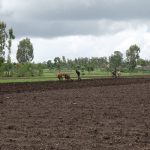IFPRI Discussion Paper 02136 We investigate whether a large-scale watershed program promoting sustainable land management (SLM) in Ethiopia increases adoption of SLM and its benefits on plots owned by women in male-headed households compared to plots owned by their spouses, jointly owned plots as well as plots of female headed households (FHH). The analysis is […]
Benchmarking policy goals and actions for healthy food environments in Ethiopia to prevent malnutrition in all its forms using document analysis
Journal Article Unhealthy diets resulting in overweight and obesity and diet-related non-communicable diseases are of increasing concern in Ethiopia, alongside persistent undernutrition, and have been linked to unhealthy food environments. Little is known about the policy response to unhealthy food environments in Ethiopia. The objective of this study was to assess how different food environment […]
Demand and supply constraints of credit in smallholder farming: Evidence from Ethiopia and Tanzania
Journal Article Credit constraint is often considered as one of the key barriers to the adoption of modern agricultural technologies and low agricultural productivity in low- and middle-income countries. Past research and much of the policy discourse associate agricultural credit constraints with supply-side factors, such as limited access to credit sources or high costs of […]
Expanding social protection coverage with humanitarian aid: Lessons on targeting and transfer values from Ethiopia
Journal Article: While social protection programmes have multiplied over the last two decades across sub-Saharan Africa, these coexist alongside humanitarian assistance in many places, calling for better integration of assistance delivered through the two channels. Progress on this front is hampered by limited evidence of whether and how these historically siloed sectors can work together. […]
Child feeding practices in rural Ethiopia show increasing consumption of unhealthy foods
Journal Article: The quality of complementary feeding can have both short- and long-term health impacts by delaying or promoting child growth and establishing taste preferences and feeding behaviours. We aimed to assess the healthy and unhealthy feeding practices of infants and young children in rural Ethiopia. We conducted two rounds of surveys in December 2017/18 […]
- « Previous Page
- 1
- …
- 36
- 37
- 38
- 39
- 40
- …
- 120
- Next Page »




